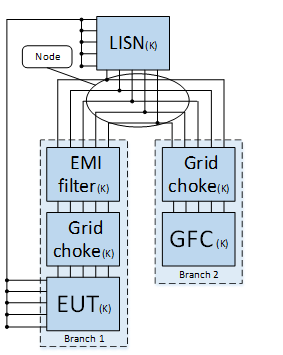Dr.-Ing. Illia Manushyn
Contact
Modern AC-AC converters most often use PWM (pulse width modulation). Besides useful and intended power transformation, all types of converters produce electromagnetic interferences (EMI) which are undesirable phenomena in power and telecommunication grids. EMI produced by converter exerts undesirable effect or even incapacitate other devices connected to the same power grid. EMI can travel in two directions: From converter to the power grid and inversely. Therefore, EMI propagation between grid and converter has to be limited in both directions. For this purpose, passive EMI filters are applied.
Currently two main approaches of EMI filtration exist – passive and active. Both type of filters have advantages and disadvantages. The main shortcomings of passive filters are size and relatively complicated design and adjustment. The bulkiest component in EMI filter is its common-mode choke (CMC) based on soft magnetic material core. The size of filters directly depends on common mode choke core permeability. Therefore the first goal of the research project are investigations on the field of soft magnetic material to find an optimum between power density, costs, insertion losses and temperature stability.
EMI noise is traditionally categorized as either differential mode (DM) or common mode (CM) noise. DM noise is the noise current flowing within the power delivery paths, while CM noise is the noise current flowing between the ground and the power circuits. For suppression of each mode a specialized passive component of EMI filter is responsible. The common-mode choke is intended to damp common mode noise, Cx capacitors (connected between power lines) are intended to attenuate differential mode. Hence damping filter characteristics have to be considered for this two types of interferences. Various combinations of filter stages give different transfer functions for the whole EMI-filter. These filter topologies should be investigated, especially in frame of implementation together with active front end converter. Additionally the opportunity of grid-choke and EMI-filter unification into one dedicated device has to be investigated.
The main trend in power converters – which is increasing of power IGBT switching frequency – helps to reduce the dimensions of frequency converters. On another hand that means the frequency of interferences which are produced during IGBT switching also rise. Stray capacitance begins to influence on CMC damping characteristics on frequency above 500 kHz and hence whole EMI filter characteristic is deteriorated. There are a lot of ways of stray capacitance cancelation but almost no information about using of this capacitance as effective element. Therefore the adaptation of damping characteristic of EMI filters for high frequencies attenuation is the third research branch on the field of EMI filter optimization.


